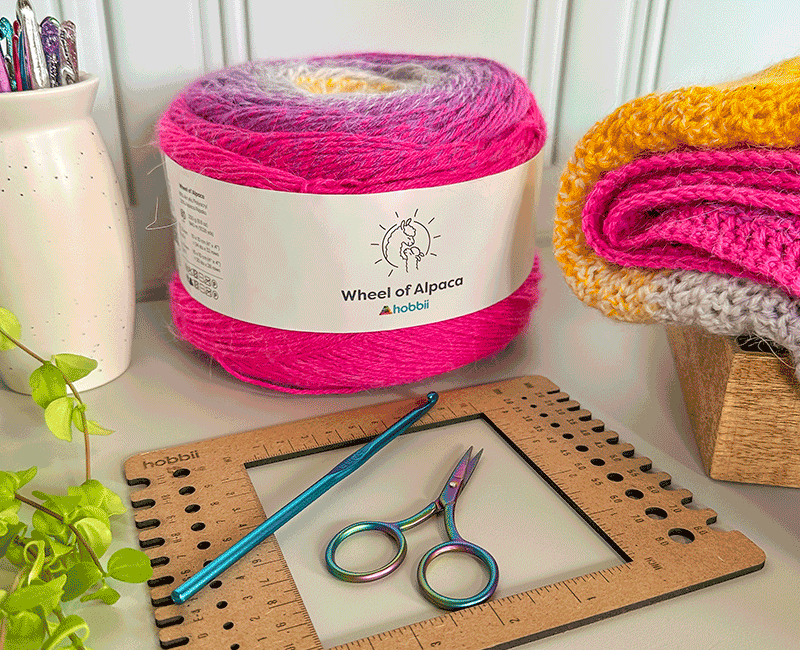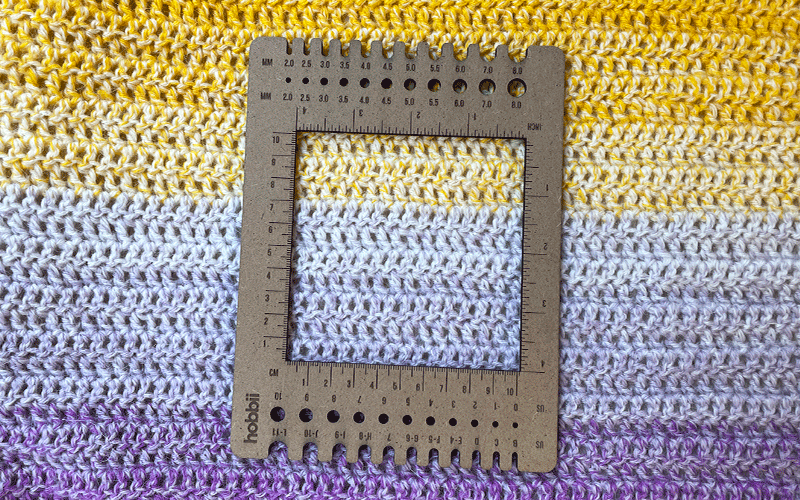In this first part, you will learn two of the techniques you will be using for the Simple Lines Shawl. We will guide you through the process with video guides and thorough explanations. And you will also need to get that crochet hook working to make your very first gauge swatch.

Yay, you have chosen to embark on an exciting crochet journey with Hobbii’s cozy crochet school and our lovely Simple Lines Shawl! I can’t wait to introduce you to this amazing hobby while we make this stunning shawl stitch by stitch.
In this first part, you will learn the following techniques
- Chain (abbreviated ch)
- Turning chain (abbreviated t-ch)
- Double crochet (abbreviated dc)
Remember the gauge swatch
First things first, you need to make a gauge swatch. A crochet gauge swatch is a tiny square made with the yarn and stitch type that you are going to use in your project. It is also crocheted with the same size crochet hook as the one mentioned in the pattern. With a swatch, you will be able to tell if you’re getting the correct number of stitches in a 10x10 (4x4 in) square. This is done to ensure that your finished project will be the correct size and, more importantly, that you have enough yarn to finish your project.
The gauge for this pattern is:
22 dcs x 9 rows = 10x10 cm / 4x4 in
A gauge swatch should, preferably, be slightly larger than 10x10 cm / 4x4 in since the first and last stitches in a row often end up being slightly tighter or looser than the actual gauge. And the same thing goes for the first and last rows in the swatch. To accommodate for this, I always make 10 more stitches than the number I need to make a 10x10 cm / 4x4 in square. For this pattern, I’m going to make a swatch with 32 stitches.

How to make a crochet gauge swatch
The first thing you need to do is make a chain with as many stitches as the number you will need for your swatch:
In the video below, I will show you how to crochet double crochets:
Video tip! Click on “Settings” (the small gear under the video ⚙) to change the language of the subtexts. You can also adjust the speed of the video if you need to rewatch the technique at a slower pace.
You can learn more about chain stitches here.TIP! Make your starting chains with a crochet hook that is half a size larger than the one you will be using for the project. The initial row of chains can easily become too tight, and it may be difficult to work your first row of stitches into it. When it is time to make the actual swatch/project, simply switch back to the hook size mentioned in the pattern.
To ensure that the sides of your swatch will be as tall as the rest of your swatch, the starting height of the next row must match the height of the stitches you are going to use. This is achieved by adding 3 chains, which in this instance correlates to the height of a double crochet.
Now you’re ready to crochet back across your chain stitches and start your crochet gauge swatch. Make a double crochet stitch in the fourth chain from your hook (the loop around the hook does not count as a chain), and continue working one double crochet into each chain.
In the video below, you will learn how to do a double crochet stitch:
You can read more about double crochets here.
Turn your swatch with 3 chains (these chains are called a turning chain (t-ch) and are made at the start of each new row) and work a double crochet into each stitch. Repeat until your gauge swatch is finished. Since this gauge swatch calls for 9 rows, you should make 4 additional rows - 13 in total. This will give you the best starting point for your measurements.
Now, measure 10x10 cm / 4x4 in in the middle of your swatch.
If the gauge doesn’t match the one from the pattern, you should consider going up or down a hook size until you hit the proper gauge.
Are there too few stitches and/or rows in the 10 cm / 4 in? Then your swatch is too big because you are crocheting too loosely. Pick up a smaller hook and try again.
Are there too many stitches and/or rows in the 10 cm / 4 in? You are crocheting too tightly, and the stitches don’t take up enough space. Try a larger hook size.
Do the gauges match? Perfect!
You can read more about gauge in our blog post The Gauge Swatch: How to measure your crochet tension.
And now we’re ready to start making that pretty shawl!
